Spatio-Temporal Patterns and Decoupling Analysis of Land Use-Related Carbon Emissions in Jilin Province
Abstract
1. Introduction
2. Materials and Methods
2.1. Study Area Overview
2.2. Data Sources
2.3. Research Methods and Ideas
2.3.1. Dynamic Degree of Land Use Change
2.3.2. Accounting of Carbon Emissions from Land Use
2.3.3. Carbon Ecological Carrying Capacity
2.3.4. Correlation Analysis Between Land Use Types and Carbon Emissions
2.3.5. Tapio Decoupling Model
2.4. Flowchart
3. Results
3.1. Dynamic Changes in Land Use Types
3.2. Spatiotemporal Evolution of Carbon Emissions from Land Use
3.3. Spatio-Temporal Analysis of Carbon Ecological Carrying Capacity
3.4. Analysis of Gray Relational Degree and Decoupling Status
3.5. Validation of the Results
4. Discussion
5. Conclusions
- (1).
- Over the period from 2002 to 2022, Jilin Province exhibited significant stage-specific variations in land use types. The area of water bodies and construction land generally showed an expanding trend, while the area of cultivated land remained relatively stable, consistently accounting for approximately 46% of total land use.
- (2).
- Spatiotemporal Variations in Carbon Emissions: The carbon emissions from land use in Jilin displayed significant spatiotemporal heterogeneity. In terms of temporal trends, the province’s carbon emissions initially increased, followed by a subsequent decline. Spatially, carbon emissions were primarily concentrated in the central region, with Changchun as the core.
- (3).
- The carbon sequestration capacity of crops in Jilin exhibited significantly higher urban variation compared to forests and grasslands. Agricultural areas, particularly cities such as Baicheng and Songyuan, demonstrated a stronger carbon sequestration capacity in crops.
- (4).
- The correlation between different land use types and carbon emissions in Jilin Province, ranked from highest to lowest, is as follows: cultivated land, woodland, water bodies, construction land, grasslands, and unutilized land. Additionally, the relationship between carbon emissions and economic development exhibited stage-specific fluctuations. Some regions, such as Baicheng and Yanbian, achieved strong decoupling of carbon emissions from economic growth, while other areas still face issues of resource-dependent growth. These regions require optimized development paths to facilitate low-carbon growth.
Limitations and Future Perspectives
Author Contributions
Funding
Institutional Review Board Statement
Informed Consent Statement
Data Availability Statement
Acknowledgments
Conflicts of Interest
References
- Foley, J.A.; DeFries, R.; Asner, G.P.; Barford, C.; Bonan, G.; Carpenter, S.R.; Chapin, F.S.; Coe, M.T.; Daily, G.C. Global Consequences of Land Use. Science 2005, 309, 570–574. [Google Scholar] [CrossRef]
- Tian, S.Q.; Wang, S.J.; Bai, X.Y.; Luo, G.J.; Li, Q.; Yang, Y.J.; Hu, Z.Y.; Li, C.J.; Deng, Y.H. Global patterns and changes of carbon emissions from land use during 1992–2015. Environ. Sci. Ecotechnol. 2021, 7, 100108. [Google Scholar] [CrossRef]
- Yang, X.H.; Jin, X.B.; Liu, J.; Gu, Z.M.; Zhou, Y.K. Design and implementation of a land use carbon emission accounting system. Bull. Surv. Map. 2019, 54–59. [Google Scholar]
- Fang, J.Y.; Chen, A.P.; Peng, C.H.; Zhao, S.Q.; Ci, L.J. Changes in forest biomass carbon storage in China between 1949 and 1998. Science 2001, 292, 2320–2322. [Google Scholar] [CrossRef]
- Lai, L.; Huang, X.J.; Yang, H.; Chuai, X.W.; Zhang, M.; Zhong, T.Y.; Thompson, J.R. Carbon emissions from land-use change and management in China between 1990 and 2010. Sci. Adv. 2016, 2, e1601063. [Google Scholar] [CrossRef]
- Feng, W.; Zhao, R.Q.; Xie, Z.X.; Wang, S.G.; Liu, Y. Land use carbon emission efficiency and its spatiotemporal pattern under the carbon neutrality goal: A case study of 72 prefecture-level cities in the Yellow River Basin. China Land Sci. 2023, 37, 102–113. [Google Scholar]
- Peng, W.F.; Zhou, J.M.; Xu, X.L.; Yang, L.; Ouyang, X.J. Effect of land use changes on the temporal and spatial patterns of carbon emissions and carbon footprints in the Sichuan Province of Western China, from 1990 to 2010. Acta Ecol. Sin. 2016, 36, 7244–7259. [Google Scholar] [CrossRef]
- Wang, Y.Q.; Zhen, W.Q. Spatiotemporal differentiation of carbon budget and carbon compensation zoning based on the plan for major function-oriented zones: A case study of counties in the Yellow River Basin. Environ. Sci. 2024, 45, 5015–5026. [Google Scholar] [CrossRef]
- Yang, Y.; Zhou, H.; Wen, G.H.; Xia, W.S.; Luo, M.Y. Land use change and its carbon effect in Dongting Lake Basin during 1980–2020. Bull. Soil Water Conserv. 2023, 43, 390–397. [Google Scholar] [CrossRef]
- Yuan, J.X.; Fang, B.; Kan, H.Y.; He, S.S. Multi-scenario simulation of carbon emission intensity and ecological profit and loss from the perspective of nature and economy in Huaihai Economic. Zone. Acta Ecol. Sin. 2024, 44, 2199–2215. [Google Scholar] [CrossRef]
- Huang, Y.T.; Zhong, Y.X.; Bi, M.Y. Effects of land use change on spatio-temporal pattern of carbon source/sink in Poyang Lake Basin. Resour. Environ. Yangtze Basin 2025, 34, 546–557. [Google Scholar] [CrossRef]
- Liu, Y.H.; Chuai, X.W.; Liang, Y.F.; Li, H.D.; Li, J.B.; Zhou, Y.; Wu, J.; Liu, G.Q.; Zhang, J.L. Evolution characteristics of carbon budgets and pressure of carbon neutrality in Jiangsu Province. Environ. Sci. 2025, 50, 1–14. [Google Scholar] [CrossRef]
- Li, Z.H.; Zhou, D.M.; Jiang, J.; Ma, J.; Zhu, X.Y.; Shi, P.; Zhang, J.; Dong, Q.H. Spatial and temporal evolution characteristics of carbon emission from land use and influencing factors in Gansu Province. Environ. Sci. 2024, 49, 5040–5048. [Google Scholar] [CrossRef]
- Shen, T.; Hu, R.; Hu, P.; Tao, Z. Decoupling between economic growth and carbon emissions: Based on four major regions in China. Int. J. Environ. Res. Public Health 2023, 20, 1496. [Google Scholar] [CrossRef] [PubMed]
- Ayitursun, S.; Ailixier, Y.; Liu, X.M.; Cai, B.F.; Chen, Q.L.; Feng, T.; Ju, C.Y.; Li, S.; Zhang, F.Y. Study on the spatiotemporal evolution of land use carbon emission intensity in Urumqi. Chin. J. Agric. Resour. Reg. Plan. 2020, 41, 139–146. [Google Scholar]
- Yang, J.; Huang, X. The 30 m annual land cover dataset and its dynamics in China from 1990 to 2019. Earth Syst. Sci. Data 2021, 13, 3907–3925. [Google Scholar] [CrossRef]
- GB/T 21010–2017; National Land Use Classification Standard. Ministry of Land and Resources of the People’s Republic of China, China Standard Press: Beijing, China, 2017.
- Intergovernmental Panel on Climate Change (IPCC). 2006 IPCC Guidelines for National Greenhouse Gas Inventories; Institute for Global Environmental Strategies (IGES): Kanagawa, Japan, 2006. [Google Scholar]
- Zhao, M.Y.; Liu, Y.X.; Zhang, X.Y. A review of research advances on carbon sinks in farmland ecosystems. Acta Ecol. Sin. 2022, 42, 9405–9416. [Google Scholar] [CrossRef]
- Tsuruta, H.; Mosier, A. Estimate of CH4 emissions from year-round flooded rice fields during rice growing season in China. Pedosphere 2005, 42, 66–71. [Google Scholar]
- Cai, Z.; Tsuruta, H.; Gao, M.; Xu, H.; Wei, C.F. Options for mitigating methane emission from a permanently flooded rice field. Glob. Change Biol. 2003, 9, 37–45. [Google Scholar] [CrossRef]
- Hergoualc’h, K.; Verchot, L.V. Greenhouse gas emission factors for land use and land-use change in Southeast Asian peatlands. Mitig. Adapt. Strateg. Glob. Change 2014, 19, 789–807. [Google Scholar] [CrossRef]
- Wu, J.; Li, K. Analysis of spatial and temporal evolution and driving factors of carbon emission in Shandong Province: Based on the perspective of land use. Environ. Sci. Eur. 2024, 36, 171. [Google Scholar] [CrossRef]
- Fang, J.Y.; Guo, Z.D.; Piao, S.L.; Chen, A.P. Terrestrial vegetation carbon sinks in China, 1981–2000. Sci. China Ser. D-Earth Sci. 2007, 50, 1341–1350. [Google Scholar] [CrossRef]
- Shi, H.X.; Mu, X.M.; Zhang, Y.L.; Lü, M.Q. Effects of different land use patterns on carbon emission in Guangyuan City of Sichuan Province. Bull. Soil Water Conserv. 2012, 32, 101–106. [Google Scholar] [CrossRef]
- Tan, J.; Liu, Q.; Tang, X.P.; Tan, X.L.; Liu, P. Spatial and temporal evolution of carbon emissions from land use and its influencing factors based on LMDI model: A case study of the Dongting Lake area. Areal Res. Dev. 2024, 43, 160–166. [Google Scholar]
- Hu, Y.Z.; Yu, D. Transmission effect and prediction of land use carbon emissions in urban agglomeration around Poyang Lake. Res. Soil Water Conserv. 2024, 31, 342–353. [Google Scholar] [CrossRef]
- Li, Y.L.; Li, S.P.; Qi, J.J. Influencing factors on carbon emissions of land uses and analysis of their decoupling effects in Shaanxi Province. Res. Soil Water Conserv. 2018, 25, 382–390. [Google Scholar] [CrossRef]
- Sun, L.G.; Liu, J.F.; Xu, Q.H.; Wang, S.Q.; Zhou, L. Effects of urban carbon emissions and their spatial-temporal patterns around Beijing and Tianjin. Geo-Inf. Sci. 2016, 32, 113–118. [Google Scholar]
- Jia, K.L.; Li, X.Y.; Wei, H.M.; Liu, R.L.; Li, H.Y.; Yang, S.Y. Spatial differentiation and risk of land use carbon emissions in county region of Ningxia. Arid Land Geogr. 2023, 46, 1757–1767. [Google Scholar]
- Sun, H.; Liang, H.M.; Chang, X.L.; Cui, Q.C.; Tao, Y. Land use patterns on carbon emission and spatial association in China. Econ. Geogr. 2015, 35, 154–162. [Google Scholar] [CrossRef]
- Guan, W.; Dong, F.C.; Xu, S.T. Spatial correlation and carbon balance zoning of land use carbon emissions in Liaoning province. J. Liaoning Norm. Univ. Nat. Sci. Ed. 2023, 46, 546–556. [Google Scholar]
- Su, Y.L.; Zhang, Y.F. Study on effects of carbon emission by land use patterns of Shaanxi Province. J. Soil Water Conserv. 2011, 25, 152–156. [Google Scholar] [CrossRef]
- Lin, X.Q.; Yang, H.J. The concept and calculation model of terrestrial ecosystem’s bearing capacity of CO2. J. Kunming Univ. Sci. Technol. Soc. Sci. 2015, 15, 71–76. [Google Scholar] [CrossRef]
- Zhang, X.P.; Zheng, G.Z. Dynamics of carbon footprint and carbon carrying capacity of Shanxi province. J. Shanxi Agric. Univ. Nat. Sci. Ed. 2016, 36, 128–132. [Google Scholar] [CrossRef]
- Xiao, L.; Zhao, X.G.; Xu, H.X. Dynamics of carbon footprint and carbon carrying capacity of Shandong Province. J. Ecol. Rural Environ. 2013, 29, 152–157. [Google Scholar]
- Zhang, X.J. The Breadth and Depth Measurement of Carbon Footprint of Energy Consumption in Yunnan and Spatial Research. Master’s Thesis, Southwest Forestry University, Kunming, China, 2022. [Google Scholar]
- Tan, X.; Deng, J. Grey relational analysis: A new method of multi-factor statistical analysis. Stat Res. 1995, 12, 46–48. [Google Scholar]
- Liang, S.; Liu, Z.; Crawford-Brown, D.; Wang, Y.; Xu, M. Decoupling analysis and socioeconomic drivers of environmental pressure in China. Environ. Sci. Technol. 2014, 48, 1103–1113. [Google Scholar] [CrossRef]
- Chen, J.D.; Wang, P.; Cui, L.B.; Huang, S.; Song, M.L. Decomposition and decoupling analysis of CO2 emissions in OECD. Appl. Energy 2018, 231, 937–950. [Google Scholar] [CrossRef]
- Huang, X.K.; Huang, Y.J.; Li, R.L.; Cheng, W.; Su, Y.; Li, F.; Du, X.X. Decoupling of land-use net carbon flux, economic growth, and population change in China. Environ. Sci. Pollut. Res. 2023, 30, 107058–107067. [Google Scholar] [CrossRef]
- Huang, R. The research on the relationship between land use and carbon emissions based on the grey model. Environ. Eng. 2016, 47, 856–861. [Google Scholar]
- Luo, Y.; Chen, S.; Liu, W.Q.; Wang, X.; Qi, A.H. Analysis and prediction on the spatiotemporal evolution of carbon emissions from land use in Hebei province. Chin. J. Environ. Eng. 2024, 18, 3360–3373. [Google Scholar]
- Yan, C.; Hou, L.G. Study on land use change and carbon emission in Shaanxi Province based on grey theory. J. Xi’an Univ. Technol. 2021, 37, 25–31. [Google Scholar] [CrossRef]
- Shi, Z.M.; Liu, Z.L.; Hao, Y.; Liu, X.Y.; Zhang, L.X. Industrial sector correlation mechanism of regional carbon emissions: An empirical study of Jilin province based on ecological network analysis. J. Beijing Norm. Univ. Nat. Sci. 2022, 58, 223–231. [Google Scholar]
- Lü, J.H.; Ji, J.Y.; Li, C.; Ye, X.Y. Analysis of energy carbon emission driving mechanism and decoupling level under “dual carbon” goal: Taking the three northeastern provinces as an example. Ecol. Econ. 2024, 40, 39–46. [Google Scholar]
- Yi, M.H.; Yan, Q.W.; Zhang, D.X.; Chen, Y.H.; Li, Y.N. Measurement of carbon emissions from cultivated land use and decoupling analysis with grain production in Jilin Province. Chin. J. Agric. Resour. Reg. Plan. 2023, 44, 45–56. [Google Scholar]
- Wang, W.; Yang, S.T.; Hai, Y.R. The spatiotemporal evolution and influencing factors of carbon emissions from land use in Ningxia. Arid Zone Res. 2025, 42, 545–555. [Google Scholar] [CrossRef]
- Sun, C.F.; Jiang, W.; Gao, W.D. Spatial-temporal evolution and influencing factors of land use carbon emissions in Shandong Province. Environ. Sci. 2025, 46, 30–40. [Google Scholar]
- Tian, H.L.; Zhu, J.H.; He, X.; Chen, X.Y.; Jian, Z.J.; Li, C.Y.; Guo, X.Y.; Huang, G.S.; Xiao, W.F. Projected biomass carbon stock of arbor forest of three provinces in northeastern China based on random forest model. Sci. Silvae Sin. 2022, 58, 40–50. [Google Scholar]
- Li, B.Y. Synergistic effects of carbon mitigation and economic growth in China: Measurement and regional disparities. J. Stat. Inf. 2025, 40, 14–25. [Google Scholar] [CrossRef]
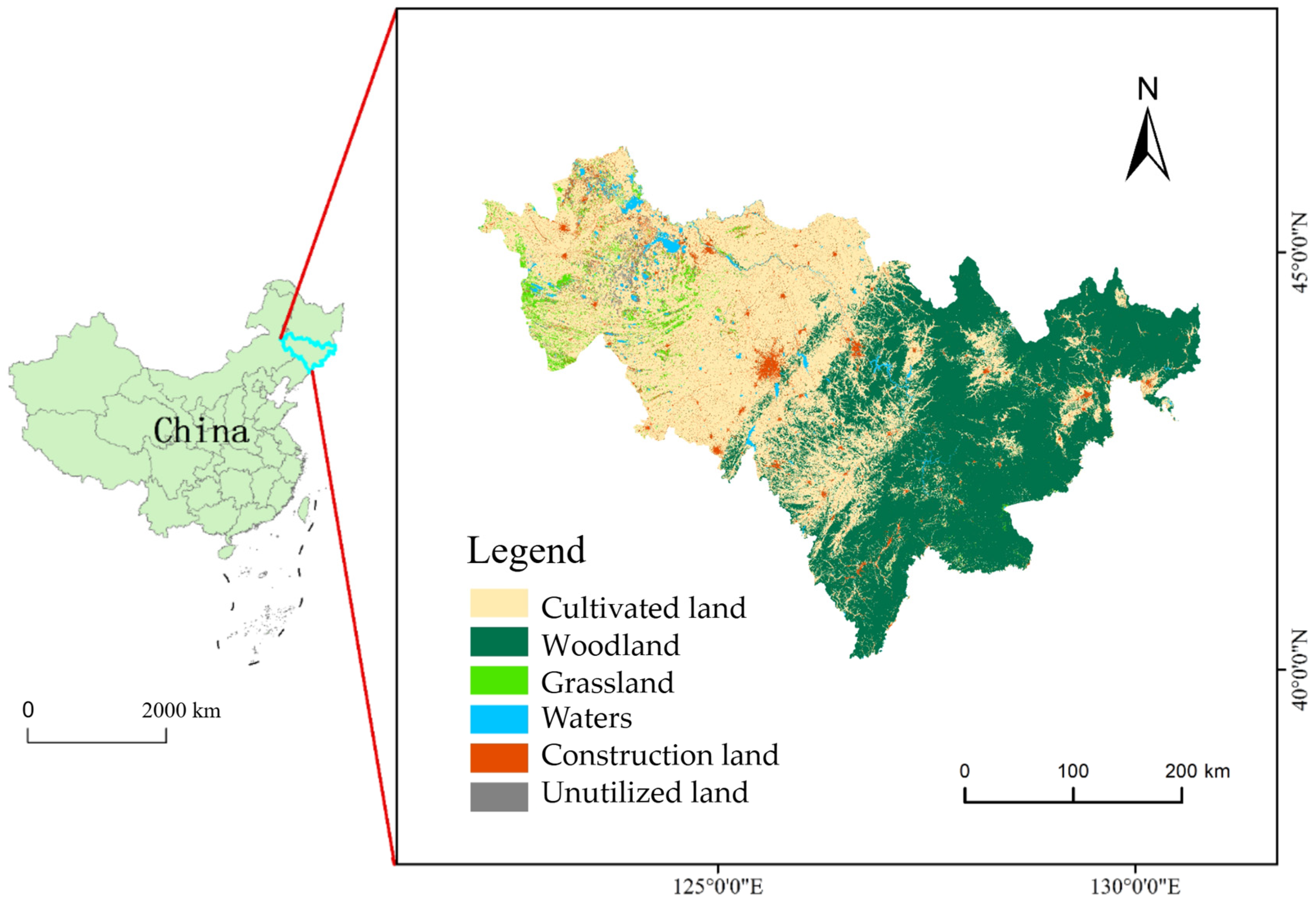

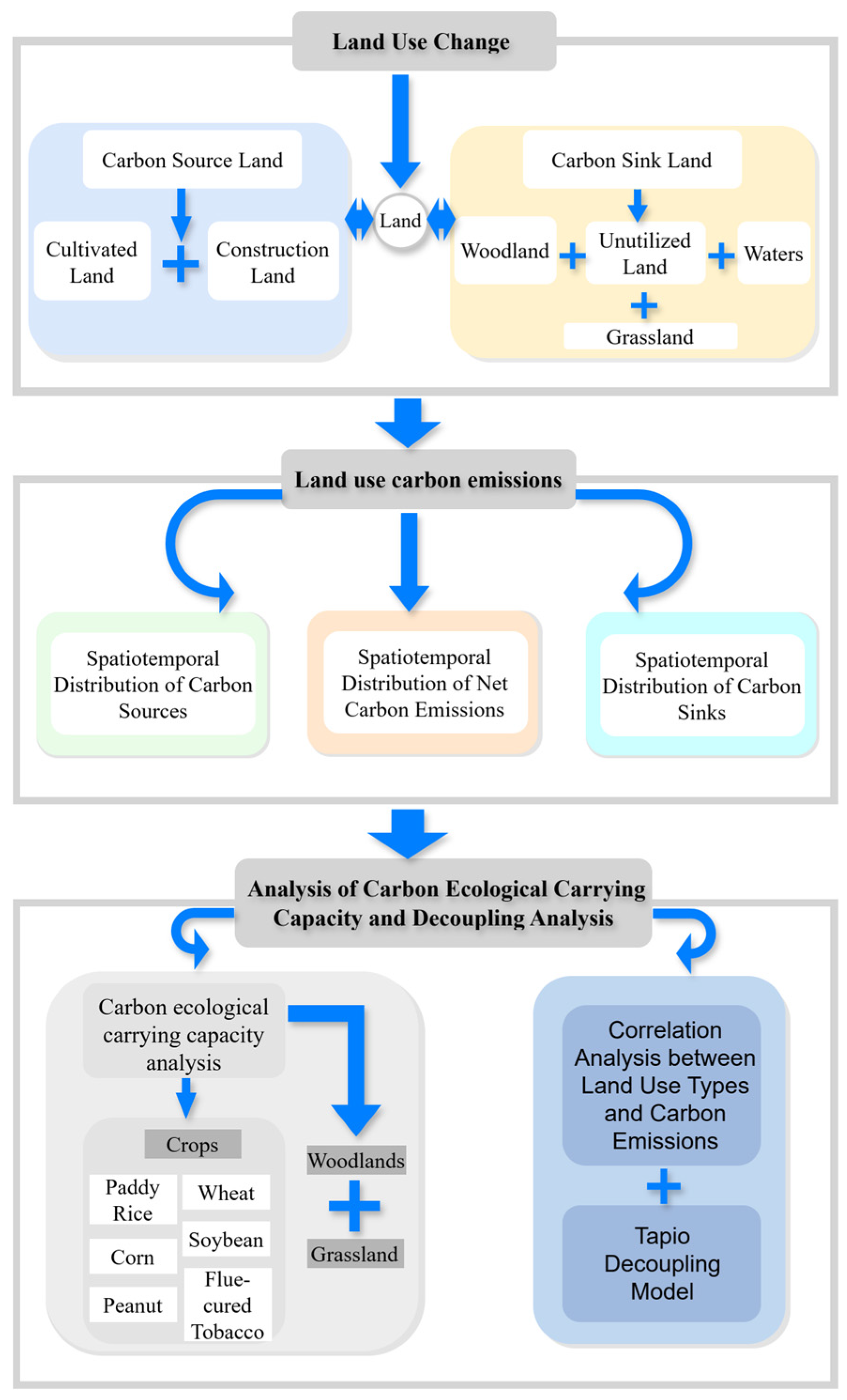

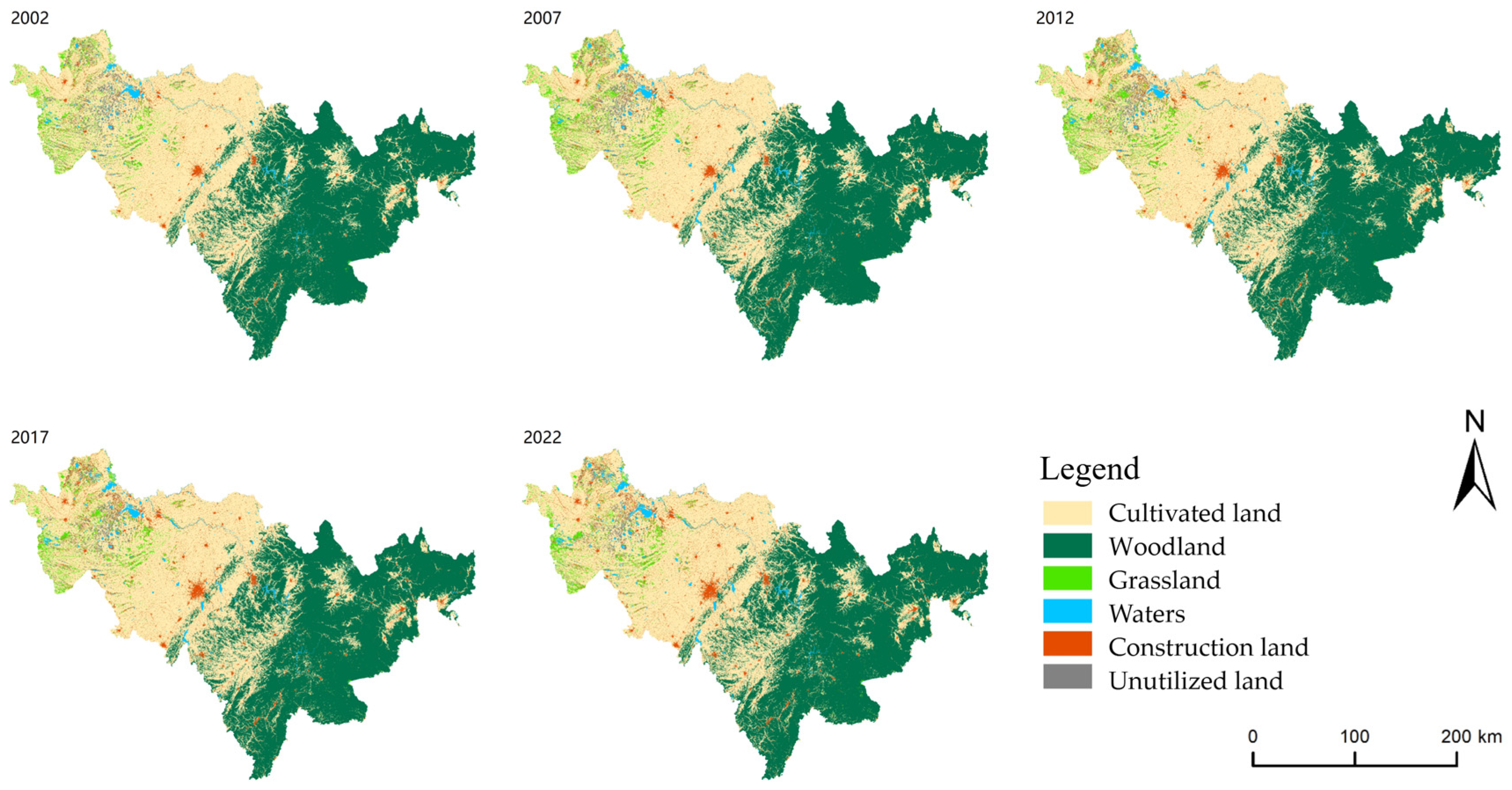
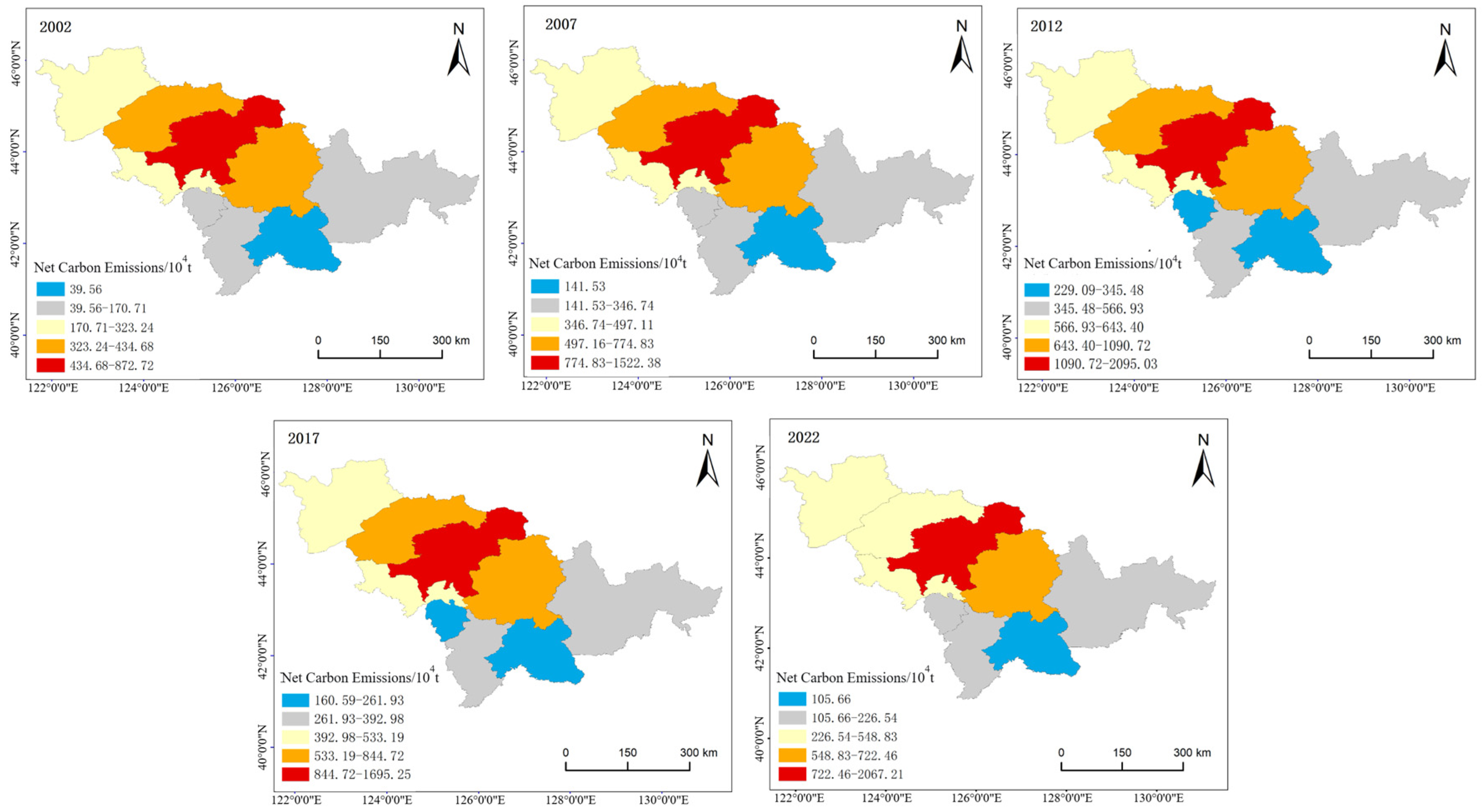

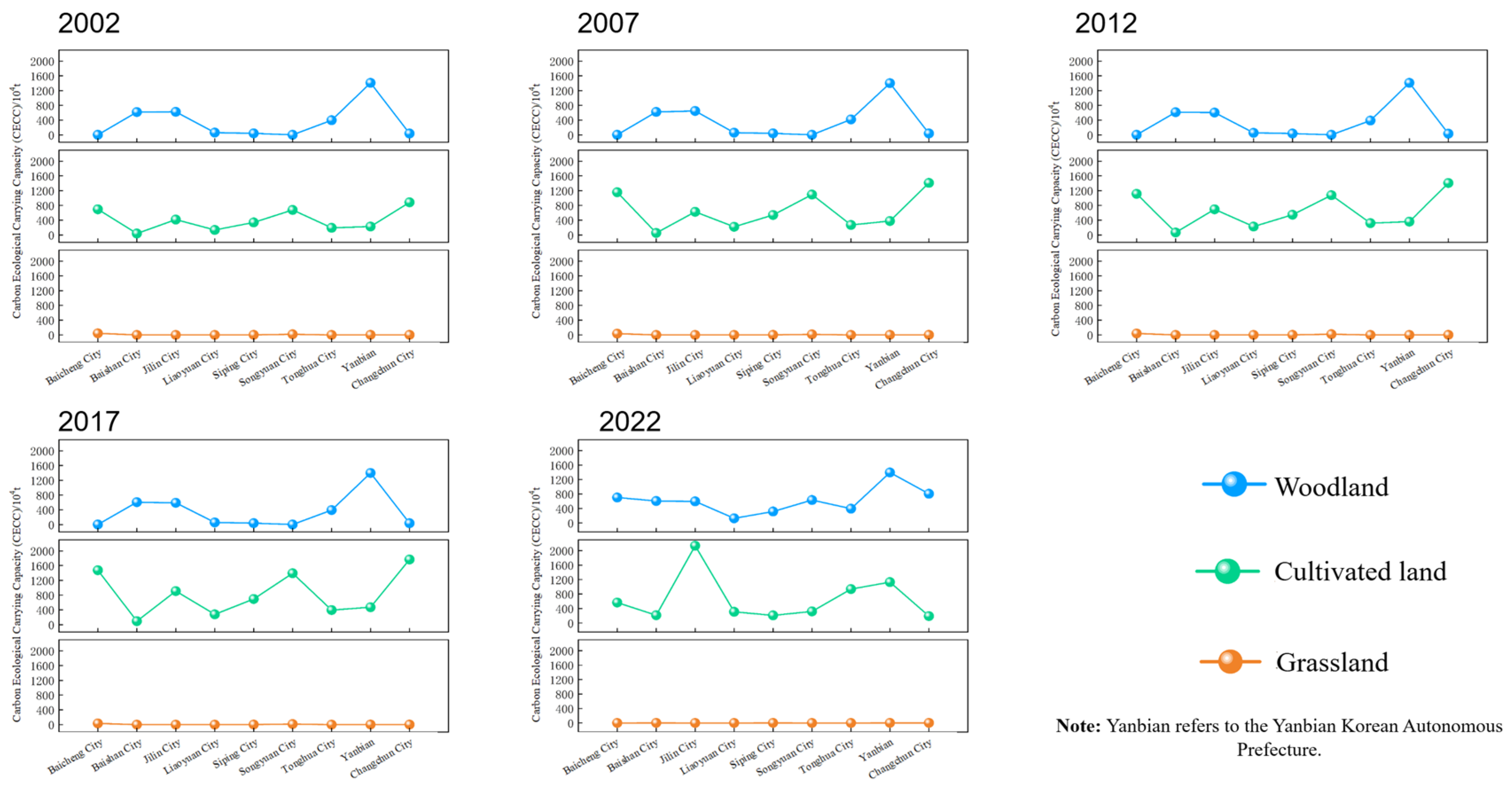
| Land Use Type | Carbon Emission Coefficient/(t·hm−2) |
|---|---|
| Cultivated land | 0.497 |
| Woodland | −0.604 |
| Grassland | −0.021 |
| Waters | −0.253 |
| Unutilized land | −0.005 |
| Types of Energy | Coal | Coke | Gasoline | Kerosene | Diesel Oil | Fuel Oil | Natural Gas |
|---|---|---|---|---|---|---|---|
| Energy standard coal conversion coefficient/(kg·kg−1) | 0.7143 | 0.9714 | 1.4714 | 1.4714 | 1.4571 | 1.4286 | 1.7143 |
| Energy carbon emission coefficient/ (kg·kg−1) | 0.7559 | 0.855 | 0.5538 | 0.5714 | 0.5921 | 0.6185 | 0.5042 |
| Type | Carbon Content (%) | Moisture Coefficient (%) | Root-Shoot Ratio |
|---|---|---|---|
| Paddy Rice | 41.71 | 11.86 | 0.60 |
| Wheat | 47.07 | 11.67 | 0.39 |
| Corn | 46.37 | 12.23 | 0.16 |
| Soybean | 44.5 | 15.00 | 0.13 |
| Peanut | 45.00 | 15.00 | 0.72 |
| Flue-cured Tobacco | 45.00 | 15.00 | 0.32 |
| Land Type | Land Use Area/km2 | Land Use Dynamic Degree/% | |||||||
|---|---|---|---|---|---|---|---|---|---|
| 2002 | 2007 | 2012 | 2017 | 2022 | 2002–2007 | 2007–2012 | 2012–2017 | 2017–2022 | |
| Cultivated Land | 89,143.88 | 87,946.63 | 88,855.98 | 89,885.43 | 89,745.28 | −0.269 | 0.207 | 0.232 | −0.031 |
| Woodland | 84,698.35 | 83,742.77 | 82,362.19 | 81,941.26 | 82,139.31 | −0.226 | −0.330 | −0.103 | 0.048 |
| Grassland | 5744.28 | 6847.79 | 6579.43 | 5402.62 | 4957.70 | 3.842 | −0.784 | −3.577 | −1.647 |
| Waters | 2368.26 | 2636.15 | 2783.61 | 2775.77 | 3179.76 | 2.262 | 1.119 | −0.056 | 2.911 |
| Construction Land | 6007.86 | 6958.41 | 7843.62 | 8702.28 | 9159.59 | 3.164 | 2.544 | 2.189 | 1.051 |
| Unutilized Land | 2796.94 | 2627.84 | 2334.74 | 2052.21 | 1577.94 | −1.209 | −2.231 | −2.420 | −4.622 |
| Year | Carbon Source | Carbon Sink | Net Carbon Emissions | ||||
|---|---|---|---|---|---|---|---|
| Construction Land | Cultivated Land | Woodland | Grassland | Waters | Unutilized Land | ||
| 2002 | 2864.40 | 443.05 | −511.90 | −1.21 | −6.00 | −0.14 | 2788.20 |
| 2007 | 5137.56 | 437.09 | −506.12 | −1.45 | −6.67 | −0.13 | 5060.28 |
| 2012 | 7106.16 | 441.61 | −497.78 | −1.39 | −7.05 | −0.12 | 7041.45 |
| 2017 | 5382.92 | 446.73 | −495.23 | −1.14 | −7.03 | −0.10 | 5326.14 |
| 2022 | 5098.79 | 446.03 | −496.43 | −1.05 | −8.05 | −0.08 | 5039.22 |
| Land Type | Relevance | Ranking |
|---|---|---|
| Cultivated land | 0.756 | 1 |
| Woodland | 0.749 | 2 |
| Waters | 0.704 | 3 |
| Construction land | 0.677 | 4 |
| Grassland | 0.626 | 5 |
| Unutilized land | 0.555 | 6 |
| City | 2002–2007 | 2007–2012 | 2012–2017 | 2017–2022 | ||||
|---|---|---|---|---|---|---|---|---|
| Decoupling Index | Decoupling Types | Decoupling Index | Decoupling Types | Decoupling Index | Decoupling Types | Decoupling Index | Decoupling Types | |
| Baicheng City | 0.433 | weak decoupling | 0.174 | weak decoupling | −37.939 | forced decoupling | 3.297 | recession decoupling |
| Baishan City | 1.886 | recession decoupling | 0.362 | weak decoupling | −11.283 | forced decoupling | 1.908 | recession decoupling |
| Jilin City | 0.890 | growth connection | 0.289 | weak decoupling | 2.477 | recession decoupling | 0.463 | weak negative decoupling |
| Liaoyuan City | 0.321 | weak decoupling | 0.201 | weak decoupling | −2.304 | forced decoupling | 0.712 | weak negative decoupling |
| Siping City | 0.696 | weak decoupling | 0.347 | weak decoupling | −1.644 | forced decoupling | 1.030 | recession connection |
| Songyuan City | 0.309 | weak decoupling | 0.209 | weak decoupling | 1.441 | recession decoupling | 0.773 | weak negative decoupling |
| Tonghua City | 1.000 | growth connection | 0.276 | weak decoupling | 4.854 | recession decoupling | 1.310 | Recession decoupling |
| Yanbian Korean Autonomous Prefecture | 2.213 | negative decoupling of growth | 0.449 | weak decoupling | 3.977 | recession decoupling | −2.356 | forced decoupling |
| Changchun City | 0.723 | weak decoupling | 0.314 | weak decoupling | −0.546 | forced decoupling | 0.908 | growth Connection |
| The whole province | 0.652 | weak decoupling | 0.311 | weak decoupling | −0.968 | forced decoupling | 0.430 | weak negative decoupling |
Disclaimer/Publisher’s Note: The statements, opinions and data contained in all publications are solely those of the individual author(s) and contributor(s) and not of MDPI and/or the editor(s). MDPI and/or the editor(s) disclaim responsibility for any injury to people or property resulting from any ideas, methods, instructions or products referred to in the content. |
© 2025 by the authors. Licensee MDPI, Basel, Switzerland. This article is an open access article distributed under the terms and conditions of the Creative Commons Attribution (CC BY) license (https://creativecommons.org/licenses/by/4.0/).
Share and Cite
Lv, W.; Liu, Y. Spatio-Temporal Patterns and Decoupling Analysis of Land Use-Related Carbon Emissions in Jilin Province. Sustainability 2025, 17, 10377. https://doi.org/10.3390/su172210377
Lv W, Liu Y. Spatio-Temporal Patterns and Decoupling Analysis of Land Use-Related Carbon Emissions in Jilin Province. Sustainability. 2025; 17(22):10377. https://doi.org/10.3390/su172210377
Chicago/Turabian StyleLv, Wenwen, and Yan Liu. 2025. "Spatio-Temporal Patterns and Decoupling Analysis of Land Use-Related Carbon Emissions in Jilin Province" Sustainability 17, no. 22: 10377. https://doi.org/10.3390/su172210377
APA StyleLv, W., & Liu, Y. (2025). Spatio-Temporal Patterns and Decoupling Analysis of Land Use-Related Carbon Emissions in Jilin Province. Sustainability, 17(22), 10377. https://doi.org/10.3390/su172210377






